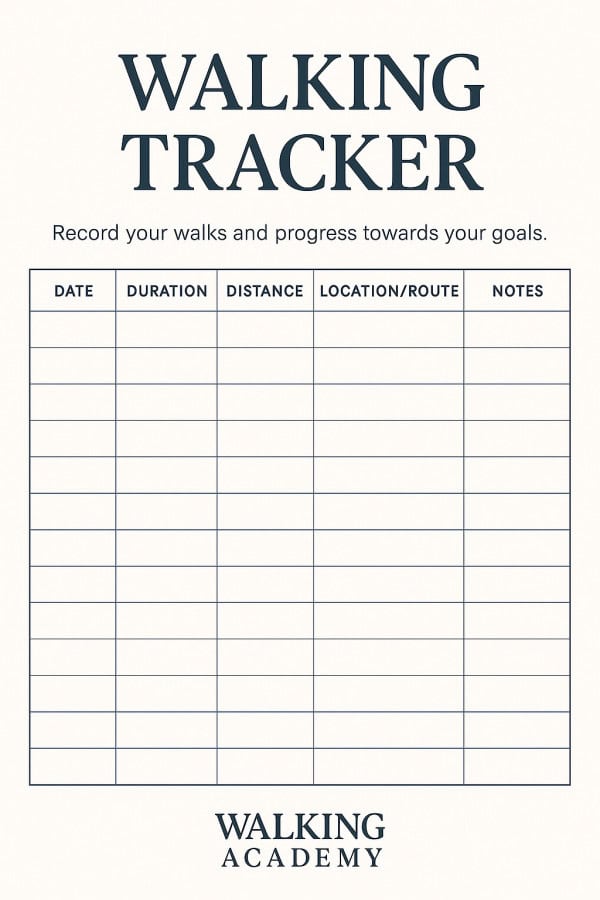Table of Contents
Some links on posts are affiliate links and will earn us a commission from qualifying purchases
In a world where we’re constantly juggling work, family life, and social obligations, carving out time for structured exercise can feel like yet another task on an already full to-do list. But what if there were a way to build fitness into your day without needing a gym membership, expensive equipment, or even a spare hour?
The good news is, there is – and it’s as simple as putting one foot in front of the other.
Walking may not have the flash of high-intensity workouts or the adrenaline rush of competitive sports, but for most people, it’s the most sustainable and accessible route to better health. And it fits seamlessly into busy lifestyles.
Fits Around Your Schedule – Not the Other Way Around
One of the biggest challenges many of us face is time. Fitting in a workout often means early alarms or late evenings – both of which can feel unmanageable.
Walking, however, doesn’t require you to block out a full hour or travel to a gym. It can be woven into the parts of your day that already exist.
Whether it’s a brisk walk to the shops, a stroll on your lunch break, or even pacing while on a phone call, walking adapts to your schedule – not the other way around.
Even short bouts of 10–15 minutes spread across the day can add up. The NHS recommends 150 minutes of moderate-intensity activity per week – walking briskly for 30 minutes five times a week gets you there.
Delivers Meaningful Physical Benefits
Don’t be fooled by its simplicity – walking offers a wide range of physical benefits.
Regular walking improves cardiovascular health, helps maintain a healthy weight, and supports stronger bones and muscles. It boosts circulation, aids digestion, and keeps energy levels steady throughout the day.
Because walking is a low-impact exercise, it’s also kind to your joints – making it an excellent option for those recovering from injury, managing long-term conditions, or simply looking for a gentler form of movement.
In fact, studies show that walking briskly can lower the risk of serious conditions such as heart disease, type 2 diabetes, and stroke.
Mental Health Boosts You Can Feel
We often think of fitness in terms of physical results – weight loss, muscle tone, or endurance. But the mental health benefits of walking are just as powerful.
A 20-minute walk, especially in green space, can significantly reduce stress and anxiety levels. The combination of movement, fresh air, and a change of scenery is remarkably effective in resetting your mood.
Walking gives your brain a chance to rest and refocus. It’s a great opportunity to process your thoughts, get a bit of headspace, and even unlock creativity. Some of my best ideas have come not while staring at a screen, but while wandering quiet country lanes.
Easy to Build into Your Day – No Drastic Changes Needed
One of the reasons walking works so well for busy people is how seamlessly it can be integrated into daily life. You don’t need to find extra time – you just need to rethink how you use the time you already have.
Here are a few small but effective ways to add walking to your routine:
- Take a 15-minute stroll after lunch – good for digestion and energy
- Park a little further away when running errands
- Swap one weekly short drive for a walk instead
- Suggest “walk and talk” meetings or phone calls
- Head out for a loop around the block before or after dinner
Consistency is what matters most. A little every day is far more powerful than a lot, once in a while.
Walking: The Unsung Hero of Long-Term Fitness
Trends come and go in the world of fitness – from bootcamps and burpees to kettlebells and CrossFit. But walking? It’s been quietly effective for thousands of years.
It’s sustainable, adaptable, and doesn’t rely on motivation alone. There’s no pressure to ‘perform’ and no risk of feeling out of place. Whether you’re in jeans and trainers or head-to-toe in performance gear, walking welcomes everyone.
It’s also incredibly inclusive. You can do it solo for peace and quiet, or with friends and family for connection. You can take it at your own pace – slow and steady, or brisk and energising.
Helpful Tools to Keep You Motivated
If you’re someone who likes a bit of structure or accountability, there are plenty of ways to stay on track:
- Use a pedometer or step-tracking app – aim for consistency over perfection
- Keep a simple walking log – jot down time, distance, and how you felt
- Set a weekly goal – start with something manageable, like 20 minutes a day
- Plan a weekend route – reward your weekday effort with a more scenic outing
You don’t need to become obsessive about data. But a little tracking can help you stay focused and build momentum.
Final Thoughts: Start Where You Are
Walking isn’t about extremes. It’s about building a habit that you can carry through the seasons – and the seasons of life.
If you’re feeling too busy to commit to exercise right now, start small. Walk around the block. Walk to the shop instead of driving. Get moving while listening to a podcast. Let the habit grow naturally.
Even a modest walking routine can be transformative over time. And unlike most quick fixes, this one’s built to last.
Ready to give it a go?
Why not challenge yourself to a simple 7-day walking streak? Just 20 minutes a day, at your own pace. By the end of the week, you might find you’re already looking forward to the next walk.
Why not print out the tracker below and start your fitness habit!

Recent Posts
If you're reading this blog post, chances are you've been on a hike before. It's great for your body and mind! But sometimes it can be hard to find the motivation to get outside again. Here I have...
Many years ago, in my teens, I used to be a runner. I wasn't an elite or even club athlete, but I used to go out plodding round the streets of my home town, and a couple of times a month me and my...


